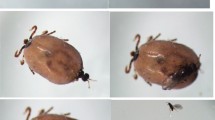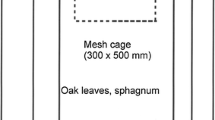Abstract
A study on development and survival of free-living stages of three important cattle ticks in Zambia,Amblyomma variegatum Fabricus,Boophilus decoloratus Koch, andRhipicephalus appendiculatus Neumann, was carried out to complement studies on seasonal dynamics of parasitic stages.
Different instars of engorged ticks were exposed under quasi-natural conditions according to the season in which they occur naturally. Generally, development rates of all stages of the three species were related to temperature, whilst the duration of survival was influenced mainly by rainfall and consequent relative humidity.
Observations on the effect of age and climate on the behaviour of ticks on pastures were also made. BothA. variegatum andR. appendiculatus completed only one generation per year. InA. variegatum, engorged females detaching early in the adult season (August to October) undergo morphogenetic diapause. Adults ofR. appendiculatus emerging between August and October enter a period of behavioural diapause before becoming active in December. These mechanisms effectively synchronize the life-cycles of these two univoltine species. The one-host tick,B. decoloratus, is able to complete three to five generations each year with no indication of seasonal synchronization.
Similar content being viewed by others
References
Branagan, D., 1973. Observations on the development and survival of the ixodid tickRhipicephalus appendiculatus Neumann, 1901, under quasi-natural conditions. Trop. Anim. Health Prod., 5: 153–163.
Newson, R.M., 1978. The life-cycle ofRhipicephalus appendiculatus on the Kenyan coast. In: J.K.H. Wilde (Editor), Tickborne Diseases and Their Vectors. Centre for Tropical Veterinary Medicine, Edinburgh, pp. 46–50.
Newson, R.M. and Punyua, D.K., 1978. The life-cycle ofRhipicephalus appendiculatus and associated species in an ecologically marginal situation in central Kenya. In: J.K.H. Wilde (Editor), Tickborne Diseases and Their Vectors. Centre for Tropical Veterinary Medicine, Edinburgh, pp. 51–55.
Pegram, R.G., Perry, B.D. and Schels, H.F., 1984. Seasonal dynamics of parasitic and non-parasitic stages of cattle ticks in Zambia. In: D.A. Griffiths and C.E. Bowman (Editors), Acarology VI. Ellis Horwood, Chichester, Vol. 2, pp. 1183–1188.
Pegram, R.G., Perry, B.D., Musisi, F.L., and Mwanaumo, B., 1986. Ecology and phenology of ticks in Zambia: seasonal dynamics on cattle. Exp. Appl. Acarol., 2: 25–45.
Pegram, R.G., Mwase, E.T., Zivkovic, D. and Jongejan, F., 1988. Morphogenetic diapause inAmblyomma variegatum (Acari, Ixodidae). Med. Vet. Entomol., 2: 301–307.
Punyua, D.K., 1984. Development periods ofRhipicephalus appendiculatus Neumann (Acarina: Ixodidae) under field conditions. Insect Sci. Appl., 5: 247–250.
Punyua, D.K., 1985. Longevity of hungryRhipicephalus appendiculatus Neumann (Acarina: Ixodidae) under field conditions at Muguga, Kenya. Environ. Entomol., 14: 392–395.
Rechav, Y., 1981. Ecological factors affecting the seasonal activity of the brown ear tickRhipicephalus appendiculatus. In: G.B. Whitehead and J.D. Gibson (Editors), Tick Biology and Control. Tick Research Unit, Grahamstown, South Africa, pp. 187–192.
Rechav, Y., 1982. Dynamics of tick populations (Acari: Ixodidae) in the Eastern Cape province of South Africa. J. Med. Entomol., 19: 679–700.
Short, N.J. and Norval, R.A.I., 1981. Regulation of seasonal occurrence in the tickRhipicephalus appendiculatus Neumann, 1901. Trop. Anim. Health Prod., 13: 19–26.
Sutherst, R.W., Wharton, R.H. and Utech, K.B.W., 1978. Guide to studies on tick ecology. CSIRO, Melbourne, Tech. Pap. 14, 59 pp.
Walker, J.B., 1987. The tick vectors ofCowdria ruminantium (Ixodoidea, Ixodidae, GenusAmblyomma) and their distribution. Onderstepoort J. Vet. Res., 54: 353–379.
Zivkovic, D., Pegram, R.G., Jongejan, F. and Mwase, E.T., 1986. Biology ofRhipicephalus appendiculatus andR. zambeziensis and production of a fertile hybrid under laboratory conditions. Exp. Appl. Acarol., 2: 285–298.
Author information
Authors and Affiliations
Rights and permissions
About this article
Cite this article
Pegram, R.G., Banda, D.S. Ecology and phenology of cattle ticks in Zambia: Development and survival of free-living stages. Exp Appl Acarol 8, 291–301 (1990). https://doi.org/10.1007/BF01202139
Accepted:
Issue Date:
DOI: https://doi.org/10.1007/BF01202139




